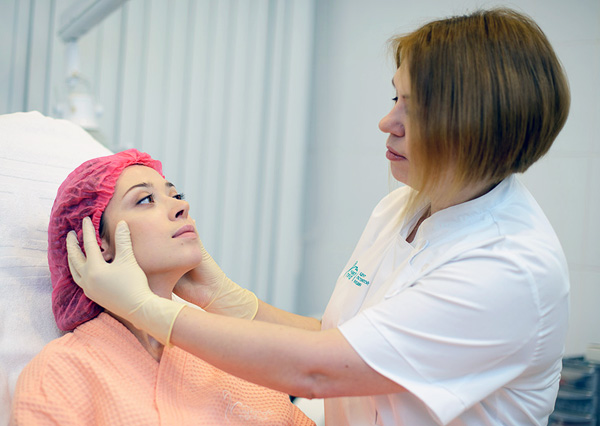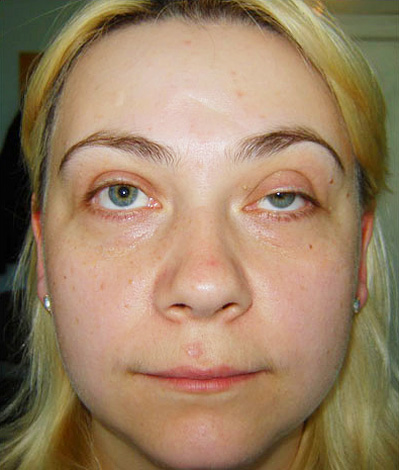
According to statistics, ptosis (omission) of the upper eyelid occurs in 16-18% of patients in cosmetology clinics after botulinum therapy. Moreover, even visitors to very expensive rooms and highly qualified doctors are not safe from such a side effect, since in many cases it develops for reasons independent of the cosmetologist.
Moreover, as a cosmetic defect, ptosis is very critical for the patient. Simply put, it catches your eye and spoils the appearance of the face more than the wrinkles themselves, which they are trying to get rid of with the help of Botox injections and similar drugs. If after such procedures the patient's eyelids go down, this not only violates the natural facial expressions, but in general looks like a pathology, giving the face an unpleasant tired expression, and the look - heaviness. In the most serious cases, blepharoptosis can even create physical inconvenience to the patient if the sagging is too strong and the eyelid literally closes the eye.
For example, the photo below shows a relatively mild ptosis that does not interfere with the patient, but affects his appearance:

And here is already a rather heavy form:
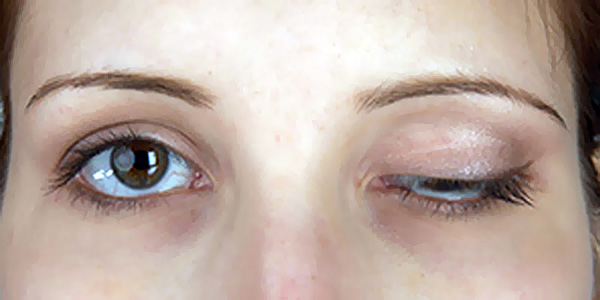
But perhaps even more unpleasant is the fact that ptosis after botulinum therapy is difficult to fix. Further we will see that there are ways to correct it, but they are very limited and do not provide a quick result.
So, even before Botox injections, you need to understand, because of which, after the procedure, there may be such a problem as how to reduce the likelihood of a side effect and what to do if the eyelids, and especially the eyebrows, have already dropped and sagged.
Why botulinum toxin injections sometimes lead to drooping eyelids
The omission of the eyelid (blepharoptosis, or simply ptosis) as a syndrome can occur for several primary reasons, of which two may occur during botulinum toxin injections:
- Partial or complete denervation with the drug of the muscle that raises the upper eyelid. In this case, the muscle does not contract either voluntarily or involuntarily, since the chain of transmission of the nerve impulse is broken at the point of contact of neurons and muscle fibers. As a result, impulses do not lead to excitement and muscle contraction. If this happened only with part of the muscle fibers, then the part that has retained activity holds the eyelid, but due to a decrease in strength, this retention does not occur completely, and the eyelid slightly drops. If the entire muscle is denervated, and it is not even able to partially hold the eyelid, the eye closes completely. It is important to note here that the eyelid drops just under its own weight - there is no special muscle lowering it;
- Due to a decrease in muscle activity, including the circular muscle of the eye and the muscle, which, when contracted, removes lymph, blood and tissue fluid accumulate in them, and edema develops. It extends to the eyelid, which becomes heavier and more heavily loads the muscle that lifts it. Due to the non-adaptation of the muscle to such a load, it cannot support the weight of the heavier eyelid, and it drops.
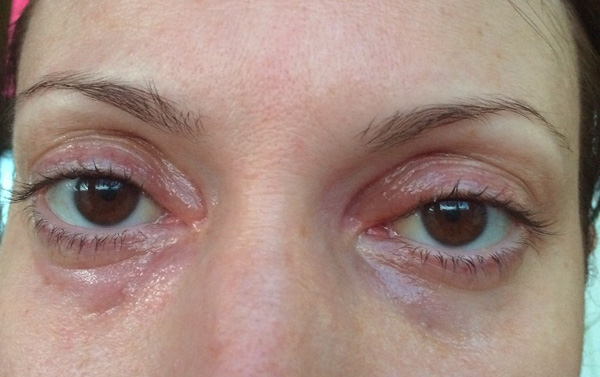
One of the causes of ptosis is swelling of the eyelid.
In some cases, ptosis after botulinum therapy is caused by both of these causes, which complement one another and lead to an increase in the effect. Moreover, due to edema, the eyelid not only drops, but also by itself increases in size and becomes more noticeable.
Sometimes ptosis is short-term and is caused only by swelling of the muscles that developed directly during injection. After a few days, this edema subsides and the eyelid returns to its normal position.
These reasons are primary, due to the very mechanisms of interaction of botulinum toxin with muscle fibers.There are also secondary reasons - those that are caused by the specifics of the procedures themselves and rehabilitation after them. Indeed, the principle of action of Botox and similar drugs on tissues is the same in all cases and in all patients, but in some, the procedure proceeds and completes successfully, while in others after it there are undesirable effects.
The most common causes of drooping eyelids
Most often, blepharoptosis after botulinum therapy develops due to various medical errors leading to an excessive effect of the drug on the tissues. In particular, they include:
- Too high dosages of the drug. As a rule, they are allowed by inexperienced doctors who, when diagnosing wrinkles, cannot independently select the optimal amount of funds. In this matter, they often focus on instructions that they receive in courses or seminars from manufacturers. The latter sellers and agents interested in selling more of the drug, in most cases, indicate excessive dosages. For example, in the corners of the eyes or forehead to completely eliminate wrinkles, it is usually enough to prick 10 units of Botox or Xeomin. At the seminars and drug presentations, the manufacturer’s representatives indicate 20–25 units to be introduced into these areas, so that cosmetologists will be guided by these standards in the future, use increased quantities of the drug and purchase it in large quantities. And when the doctor introduces such quantities, the de-eyelid muscle is deactivated - because of the high dosages, the drug spreads in the tissues more extensively than the cosmetologist expects and acts on those muscles that were not supposed to be inactivated;

The amount of Botox in the corners of the eyes usually should not exceed 15 units.
- Errors in the dilution of the product when an insufficient amount of water or saline solution is used to prepare the injection solution and the strength of the volume unit of the product is higher than that provided by the manufacturer. As a result, by injecting the same amount of solution, the doctor administers large doses of botulinum toxin, which leads to an excessive effect and deactivation of non-target muscles;
- Inaccuracies in the choice of injection sites. In this case, the doctor may accidentally get a needle into the muscle that lifts the eyelid, instead of another muscle, or the drug can be injected not into the center of the target fiber, but into the edge, and part of it “spreads” along the nearby fibers, which were not originally planned to be processed.
In the latter case, by the way, the error can be caused by both insufficient knowledge of the anatomy of the muscles of the face, and anomalies in their structure and location in a particular patient. Nevertheless, the responsibility for the consequences lies with the doctor: it is he who must before the procedure sufficiently study the features of the anatomy of the face of a particular patient and the specifics of the location and contraction of his muscles.
On a note
Inexperienced cosmetologists in most cases work "point by point", that is, they make injections in standard places, the layout of which is described in various manuals and textbooks. In this case, they do not take into account the individual features of the location and anatomy of the facial muscles of the patient and that is why they sometimes allow the introduction of the toxin into non-target tissues. The consequence of such stereotyped work can be not only ptosis: situations are known where the cheeks, the corners of the lips, the edges of the eyes, and even the muscles of the forehead drop.

A professional, knowing well the location of the facial muscles, will always take into account the individual anatomical features of the patient's face.
However, often ptosis occurs for reasons beyond the control of a physician. The main one is the patient's increased sensitivity to botulinum toxin. In this case, the dosages that are correct for most people turn out to be too high and lead to excessive muscle blockade, including leading to blepharoptosis.It is impossible to predict such sensitivity in the first procedure, and in subsequent only the patient can inform the doctor about it.
Another case is a patient's violation of the conditions of the rehabilitation period after injections. If a person in the first hours after therapy takes, for example, a hot bath, exercises in the gym, consumes undesirable pharmaceuticals, botulinum toxin can spread more actively in his tissues than is expected by a doctor, and will also affect the muscle that lifts the eyelid.
In a real situation, it is not always possible to find out the cause of ptosis. Moreover, often this side effect develops due to several reasons. In any case, an understanding of why blepharoptosis has developed is just information for the future, when the patient will choose in which office to inject Botox the next time. When ptosis has already developed, it is more important to figure out how difficult the situation is in a particular case, whether it will go away on its own and what are the ways to eliminate it.
The severity of the undesirable effect
Ptosis itself can manifest itself in different ways depending on the individual characteristics of the face, on how much the eyelid has fallen, and on whether additional complications have developed.
In the easiest case, there is no obvious prolapse of the eyelid, there is not even a noticeable asymmetry, but sagging the eyelid even by a fraction of a millimeter already gives the face a certain shade of fatigue. The photo shows the following case:
As a rule, in such situations, patients prefer not to take any additional measures, since the effect is compensated relatively quickly by restoring muscle activity.
A more complicated case is a noticeable omission of one eyelid with pronounced asymmetry, when one eye covers itself more than the other. In a mild form, such ptosis does not cause physical inconvenience or visual impairment in the patient, but attracts the attention of others.
If both eyes are similarly noticeably covered, a person has a hard look, like sullenness, which is already considered a serious defect.

Blepharoptosis of both eyes is a severe injury that causes the patient a lot of unpleasant problems.
Finally, it is critically inconvenient to completely close the eyes with impaired vision. In this case, to compensate for the effect and raise the eyelid, radical methods are used.
Additional complications may exacerbate the cosmetic effects of ptosis. For example, the already mentioned swelling of the century leads to its even greater omission and visual highlight. In many cases, for the same reasons that ptosis occurs, the eyebrow is lowered. This leads to its overhanging over the eye, which in general creates the effect of a gloomy face, more noticeable than the original wrinkles.
Finally, edema and bumps, sometimes occurring after botulinum therapy in addition to ptosis, give the face a painfully swollen appearance. And if the eyelid also twitches, it is invisible to others, but it causes discomfort to the patient.
Look at the photo - this is exactly what such a swollen face is shown on the second day after botulinum therapy:

Fortunately, the edema itself and such neurological consequences after injections usually pass quite quickly - in a few days. Ptosis can last much longer.
Feedback
“Yesterday, Botox injected for the first time, and so it is - the first pancake is lumpy. They did at least 10 units in the eyebrow and forehead, 3 units in the corners of the eyes. Specially decided to stab a little so that nothing bad would happen. But no, it was impossible so that without trouble. Today the eyelids are swollen and, as it were, lay on eyelashes. In the morning it was generally bad - as if they were hanging, but then gradually decreased and only a fold remained. Everything is beautiful on the bridge of the nose, and here ... And it catches your eye, my eyes have always been wide open, and here they are outlined by this fold.I called the doctor, she said that the problem in the muscle, which is responsible for the removal of lymph, this should go away quickly - in a week somewhere. But I worry - nothing happens to other girls, their eyelids do not swell. Maybe somehow it’s possible to remove this case, so as not to wait a week? ”
Elena, Novosibirsk
Does ptosis pass on its own
Blepharoptosis, caused precisely by the action of botulinum toxin, in almost all cases passes independently when the drug is completed. The mechanism here is the same as when restoring wrinkles eliminated by the drug: a nerve cell, the synapses of which on a particular muscle fiber were inactivated, forms new processes and new places of contact with the muscle, gradually restoring control over muscle contraction.
It is interesting
The formation of new processes of the nerve cell begins already on the 2-3rd day after getting botulinum toxin into the nerve synapses and their inactivation. The duration of the restoration of muscle activity is explained by the low growth rate of nerve fiber - this is one of the slowest growing tissues in the body.
Therefore, when wrinkles are restored, ptosis is also eliminated, since the normal activity of the muscles injected with the botulinum toxin preparation resumes.
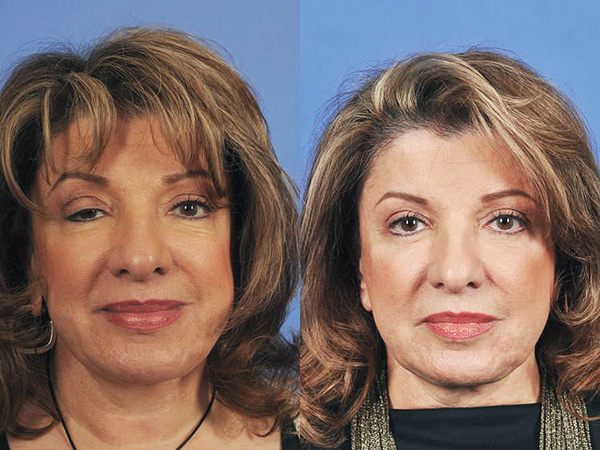
After muscle activity is restored, ptosis passes by itself, however, this process takes several months.
When will the eyelids fully recover?
A full natural restoration of the position of the eyelids usually occurs after 7-8 months, however, these periods are determined by the individual characteristics of the body and the amount of drug administered.
So, in some patients Botox and its analogues cease to work after 5-6 months, while in others this period lasts up to 13-15 months. However, these cases are rare, and it is considered to be the norm precisely 7-8 months for normal doses of Dysport or small doses of Botox and its analogues, or 9-12 months for normal doses of Botox.
If ptosis is caused only by edema and a heavier eyelid after injections, but has not arisen due to the action of the drug on the muscle that lifts the eyelid, it will pass immediately when the edema also passes - in the period from two to ten days. If, after the procedure, the edema did not develop at all, or it has already arisen and passed, and the ptosis has persisted, it means that this complication is long-lasting and will pass by itself only when the effect of Botox injections is completed.
Methods for correcting the position of the eyelids and eyebrows
There are several ways to remove ptosis caused by injections of neurotoxins. The most effective, natural and safe, but also the longest in terms of obtaining the expected effect is the stimulation of the muscle that raises the eyelid with various physiotherapeutic procedures. With such stimulation in the muscle, metabolic processes accelerate and its innervation is restored faster. In addition, with partial ptosis, those fibers that retain activity “train” and more effectively raise and hold the eyelid, over time taking on part of the load from the inactivated part of the muscle. As a result, ptosis during such procedures is faster. Practice shows that with a deliberate struggle against it, it is possible to achieve that the normal position of the century will be restored in 3-4 months.
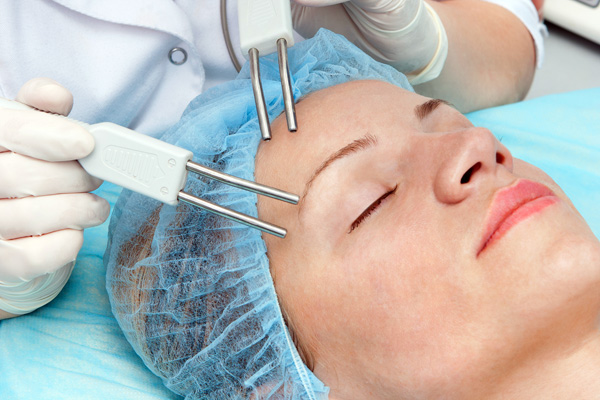
One of the effective physiotherapeutic methods of combating drooping of the eyelids is galvanization.
Such procedures are often carried out for cosmetic purposes, are well tolerated by patients and are often familiar to them. In particular, for the treatment of ptosis are carried out:
- Muscle massage is the simplest procedure, which after several sessions the patient can master and carry out independently. It helps to activate metabolic processes in the muscle and accelerate its reinnervation;
- Microcurrents that promote the regeneration of various structures in the skin, and in some cases in the muscles. With correctly selected current parameters, they accelerate the restoration of the innervation of muscle fibers;
- Thermolifting, providing some skin tightening, and with it a slight lifting of the eyelid. In some cases, this is enough to eliminate the defect;
- The installation of microfilaments giving a result similar to thermolifting is a skin tightening, and with it the eyelids.
Microcurrents and muscle massage can reduce the time for eliminating ptosis to 3-4 months, thermolifting and microfilament therapy - up to 2-3 months. However, in most cases it is impossible to combine these procedures because of the risk of side effects.
It is important to remember that the cost of such procedures may be greater than the cost of botulinum therapy itself. Therefore, the feasibility of conducting them each patient determines independently.
It is also possible the introduction of some stimulant drugs. Of these, injections of Prozerin, Neuromultivitis or Neuromidin, mesotherapy with DMAE preparations, as well as Apraclonidine eye drops are most often used. They will not give a quick and powerful result, but in a few weeks they will allow you to raise the eyelid by 1-1.5 mm. In some cases, this is enough.

Some drugs can lift the eyelid up to 1.5 centimeters in a few weeks.
Finally, the introduction of botulinum toxin into the lower part of the circular muscle of the eye, which ensures its closure and lowering of the eyelid, is sometimes considered as an option for correcting drooping eyelids. Since there is no antagonist for the muscle that lifts the eyelid, this option is not very effective, but it can be achieved that the eye opens slightly wider than it does in the normal state. Visually, this compensates for the effect of a dropped eyelid.
However, this method is unpredictable. Firstly, normally the circular muscle of the eye does not pull the eyelid down and therefore does not cause ptosis with a relaxed upper muscle. That is, not necessarily its relaxation will lead to the raising of the eyelid: here a lot depends on the distribution of toxin in the tissues after the first procedure. Secondly, if you accidentally inject a little more than the required amount of the drug into the pretarsal part, you can completely deactivate it, because of which the patient will not be able to close the eyelids at all.
For these reasons, Botox is rarely “pushed” into the lower part of the eye to combat ptosis.
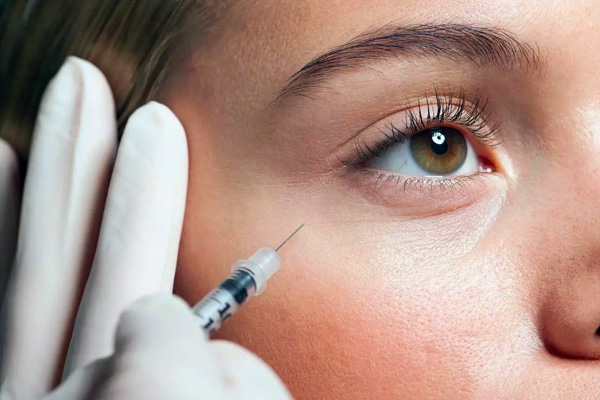
Injections into the lower part of the eye to raise the eyelid do not guarantee the expected result, therefore they are usually not given.
On a note
With pathological blepharoptosis (that is, one that is caused by impaired muscle function, rather than botulinum therapy), sometimes just botulinum toxin is used, but this is done only when the doctor has accurately diagnosed the causes of the condition and is absolutely sure of the effectiveness of the procedure. Normally, an attempt to lift the eyelids with Botox is ineffective due to the specific structure of the circular muscle of the eye. But for raising eyebrows, botulinum toxin preparations are quite suitable - with the right injection points you can relax the muscles that lower the eyebrows, as a result of which the eyebrows will rise. Here, again, the high precision and professionalism of the cosmetologist is required, who can raise the eyebrows by a sufficient amount, but will not allow their excessive tearing and the effect of “Mephistopheles eyebrows”.
Ptosis removal operations after botulinum therapy are never performed.
Methods of compensating or masking asymmetry
There is also an original way to “mask” minor blepharoptosis, which consists in introducing botulinum toxin into the muscle that lifts the eyelid in the second eye. In this case, the eyelid will also drop slightly, which will hide the asymmetry, and ptosis will not be evident as a result.
This method also requires high professionalism from a cosmetologist and is not suitable in all cases.At a minimum, the doctor should practically select the dosage in jewelry and administer Botox so that the eyelid drops exactly the same height as on the other eye. But the main disadvantage of this method is that with both eyelids lowered, the patient’s face will look somewhat “tired”.
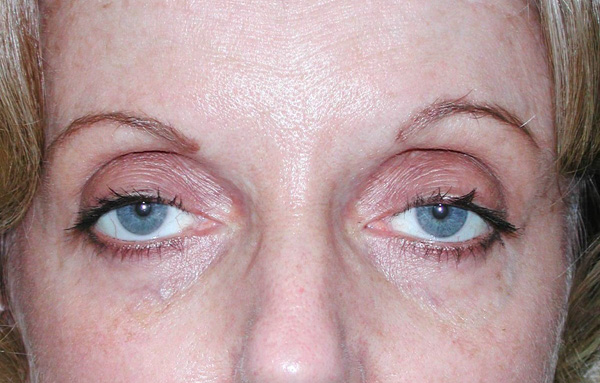
For the symmetry of the eyelids, botulinum toxin is sometimes administered on the other eye.
As a result, such compensation is only suitable for patients with an appropriate face - tall, open, with big eyes and characteristically raised eyelids. They have a slight omission of both eyelids will not be noticeable, and sometimes even allows you to decorate the face. For people with a wide face, massive eyebrows and noticeable cheekbones, this disguise is contraindicated - their eyelids open will make the face very heavy.
How to prevent similar complications in the future
If, after the procedure, the eyelids have already fallen and measures have been taken to compensate for this effect, care must be taken to ensure that such an effect does not recur in the future. Since botulinum therapy itself is carried out regularly, the following procedure will require a more careful approach and the high likelihood of ptosis. In order to prevent similar troubles in the future, it is necessary:
- The cosmetologist’s warning about such an effect: knowing that blepharoptosis has already happened once, the doctor will try to find out its causes and, in accordance with this, select dosages, select injection points and, possibly, sacrifice the cosmetic effect of the procedure for its safety;

A cosmetologist should be warned about complications after past procedures so that relapse does not recur.
- Clarification of the causes of complications. To do this, it is useful to consult another cosmetologist - if there is a chance that the reason is a doctor’s mistake, the following procedure is best done with another specialist;
- If with a certain probability ptosis arose due to violations by the patient of the conditions of the rehabilitation period, then it is necessary to draw conclusions and prevent such violations in the future. Moreover, the doctors’s recommendations for observing the rules of the rehabilitation period did not arise from scratch - they are a consequence of the analysis of side effects and complications and are developed just to reduce the risk of such consequences to a minimum.
Finally, you need to understand that the professionalism of the cosmetologist and the reputation of the clinic are the main guarantee of the safety of the procedure and the least likelihood of ptosis. An experienced and professional doctor is unlikely to make a mistake with the dosage and will not “miss” the target muscle. And in the event that even the eyelid falls through no fault of his own, he will help to cope with this defect.
Complications after Botox as a consequence of the lack of professionalism of a cosmetologist
Useful video about the most common complications after botulinum therapy

